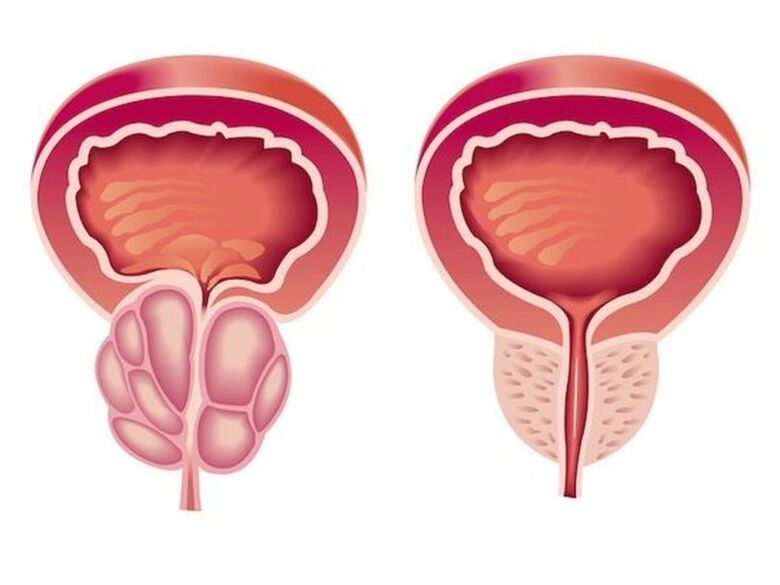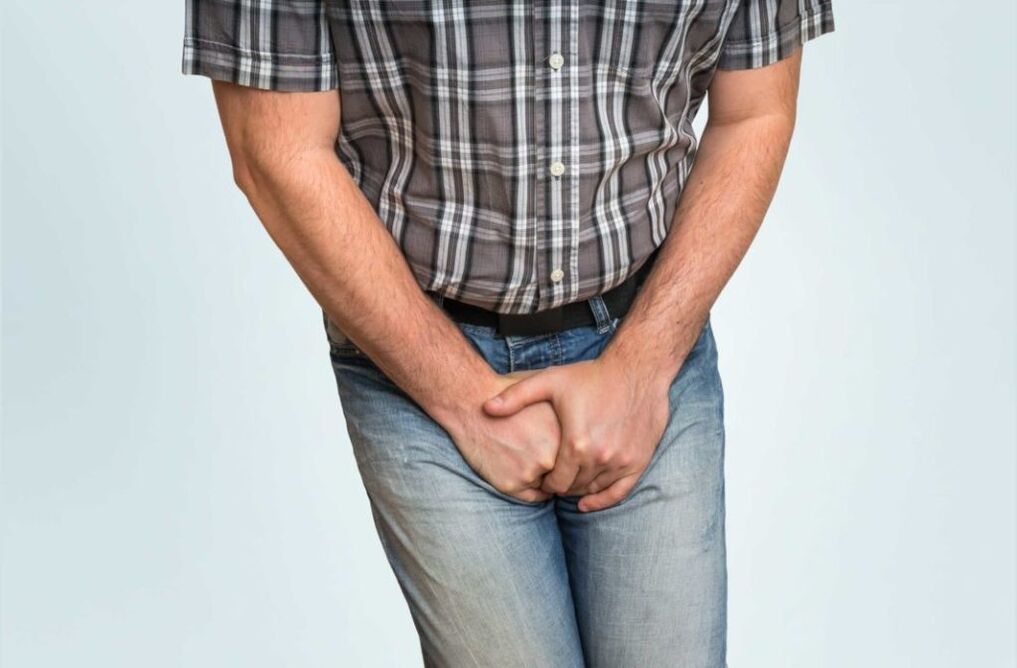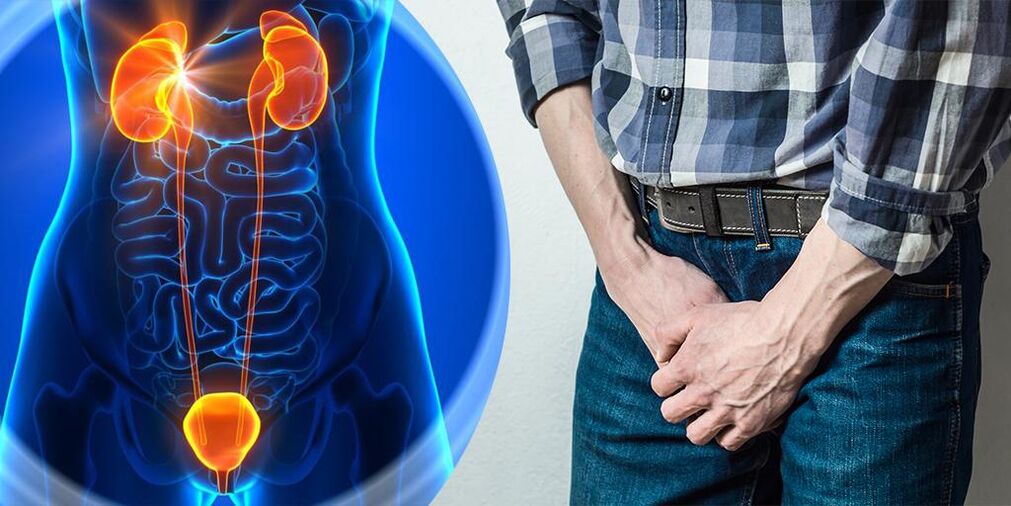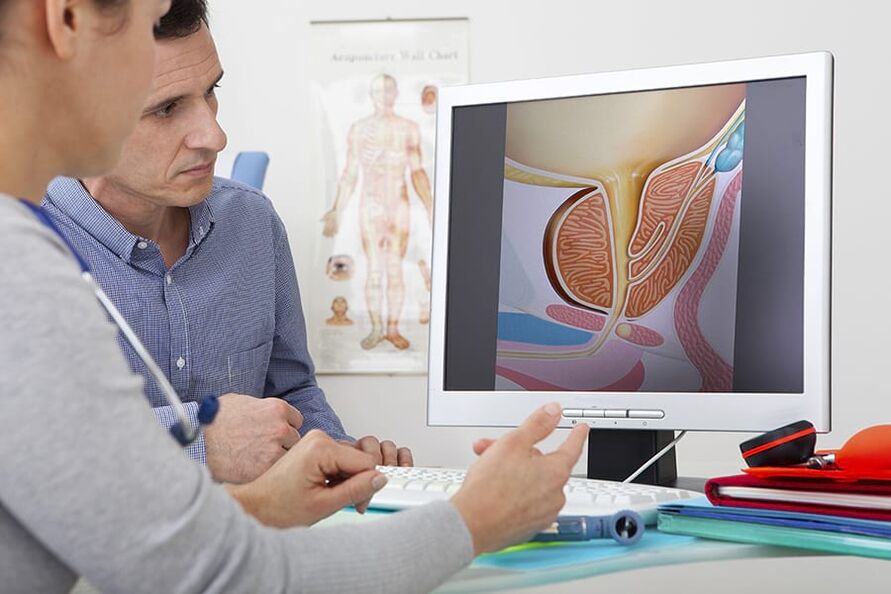Prostatitis is an inflammatory disease of the prostate gland. It manifests itself through frequent campaigns in the toilet, pain in the penis, scrotum, rectum, sexual disorders (erection, early ejaculation, etc. ), sometimes delayed urine and blood insurance in urine. The diagnosis of prostatitis is determined by a urologist or another specialist in a typical clinical image, the results of a rectal study. In addition, an ultrasound of the prostate is carried out, the bacteria of the prostate secretion and urine saw. Conservative treatment - antibacterial therapy, immunotherapy, prostate massage, lifestyle correction.

General information
Prostatitis - inflammation of the seeds (prostate) - prostate. It is the most common disease of genitarians in men. Most of the time it affects patients aged 25 to 50. In accordance with various data, prostatitis suffers below 30-85% of men over 30 years. The rise of the infection leads to inflammation of the upper parts of the genitarian system (cystitis, pyelonephritis).
The pathology develops when an infectious means of infectious forms from the organs of the genitarian (urethra, bladder) or from a remote inflammatory focus (with pneumonia, flu, almond inflammation, furunculose).
The causes of prostatitis
A golden staphylococcus aureus (enterococcus), enterobacter (enterobacter), pseudomonas (pseudomonas), Proteus (Proteus) and Klebcelllah and Klebcelllah can occur in an acute process. (Klebsiella) and E. Coli (E. coli). Most microorganisms belong to a limited pathogenic flora and only cause prostatitis if other predisposing factors are present. Chronic inflammation is usually caused by Paul with microbial associations.
The risk of developing the disease increases during the hypothermia, the presence of specific infections and diseases in the prehistory of congestion in the tissue of the prostate. The following predisposing factors are differentiated:
- General hypothermia (individually or permanently, in connection with working conditions).
- A sitting lifestyle, a specialty that forces a person to be in a seated position for a long time (computer operator, driver, etc. ).
- Constant constipation.
- Violations of the normal rhythm of sexual activity (excessive sexual activity, longer abstinence, incomplete ejaculation during the emotional coloring of "usual" sex).
- The presence of chronic diseases (cholecystitis, bronchitis) or chronic infectious herds in the body (chronic osteomyelitis, absurd caries, tonsillitis, etc. ).
- Translated urological diseases (urethritis, bladder infection, etc. ) and sexually transmitted diseases (trichomoniasis, gonorrhea).
- States causing the inhibition of the immune system (chronic loads, irregular and inferior diet, regular lack of sleep, an exaggeration state for athletes).
It is believed that the risk of pathology increases with chronic poisoning (alcohol, nicotine, morphine). Some studies in the field of modern andrology prove that the provocative factor is a chronic step injury (vibration, concussion) for car drivers, motorcyclists and cyclists. However, the overwhelming number of experts believe that all of the circumstances listed are not a real causes of the disease, but only to aggravate the latent inflammatory process in the tissues of the prostate.
The crucial role in prostatitis is played by stagnation in the tissue of the prostate. A violation of the capillary blood flow leads to an increase in lipid peroxidation, edema, the radiance of prostate tissues and forms the conditions for the development of the infectious process.

Symptoms of prostatitis
Acute prostatitis
There are three stages of acute prostatitis, which are characterized by the presence of a certain clinical image and a certain morphological changes:
- Sharp categral. The patients complain about a quick, often painful urination, pain in the sacrum and perineum.
- Sharp follicle. The pain becomes more intense, sometimes radiates on the anus and increases during the defecation. Urinating is difficult, urine currents with a thin stream. In some cases, a urine delay is determined. Subfebrilit or moderate hyperthermia is typical.
- Acute parenchymal. Pronounced general poisoning, hyperthermia up to 38-40 ° C, shaking frost. Dizurian disorders, often an acute delay in urination. Sharp, pulsating pain in the perineum. Difficulty to empty.
Chronic prostatitis
In rare cases, chronic prostatitis becomes the result of an acute process. As a rule, however, a primary chronic course is observed. The temperature occasionally increases to small values. The patient notices weak pain in the perineum, symptoms during urination and defecation. The most characteristic symptom is the shorter discharge from the urethra during stool. The primary chronic form of the disease develops over a significant period of time. In front of her she takes the blood stagnation of blood in the capillaries and gradually turned into factual prostatitis.
Chronic prostatitis is often a complication of the inflammation process caused by the causal active ingredient of a specific infection (chlamydia, urea, urea, gonococcal). Symptoms of a specific inflammatory process In many cases, the manifestations of the prostate manifestate mask. It is possible that weak pain in the perine, a low pain in the perine, a short discharge of the urethra during the defecation. A slight change in the clinical image is often unnoticed by the patient.
Chronic inflammation of the prostate gland can be manifested by a burning feeling in urethra and perineum, dysuria, sexual disorders and increased general fatigue. The consequence of potency violations (or fear of these violations) often becomes mental depression, fear and irritability. The clinical image does not always contain all groups of symptoms listed, differs in different patients and changes over time. There are three main syndrome that are characteristic of chronic prostatitis: pain, violations when walking to the toilet, sexual disorders.
There are no pain receptors in the prostate. The cause of pain in chronic prostatitis is almost inevitable due to the participation of the pelvic organs in the inflammatory process of the nervous paths. The patients complain about pain from different intensity - from weak, painful to intensive, violating sleep. There is the nature of the pain (improvement or weakening) with ejaculation, excessive sexual activity or sexual abstinence. Pain shines on a scrotum, a sacrum, a step, sometimes into the lumbar cone region.

As a result of inflammation in chronic prostatitis, the volume of the prostate that presses the urethra increases. The lumen of the ureter decreases. The patient has frequent urination, a feeling of incomplete emptying of the bladder. As a rule, dysurical phenomena are expressed in the early stages. Then a compensatory hypertrophy of the muscle layer of the bladder and the ureter develops. The symptoms of a dysuria during this time weaken and then increase during the decompensation of adaptive mechanisms.
In the initial phases, violations of the effectiveness that manifest themselves differently in different patients can develop. Patients can complain about frequent night elections, a deleted orgasm or a deterioration in an erection. The accelerated ejaculation is associated with a decrease in the stimulation of the threshold of the center, which is responsible for obtaining an orgasm. Pain against ejaculation can lead to a rejection of sexual activity. In the future, sexual disorders will become more pronounced. Impotence develops in an advanced stage.
The degree of sexual disorder is determined by many factors, including the sexual constitution and the patient's psychological mood. Violations of potency and dysuria can be attributed to changes in the prostate and on how easily the patient can inspire everything. If he has chronic prostatitis, this expects the inevitable development of sexual disorders and urine disorders. Psychogenic disorders in potency and problems with the inclusion on the toilet in cute, alarming patients develop particularly often.
Complications
In the absence of timely treatment of acute prostatitis, there is a considerable risk of developing the abscess of the prostate. When the purulent focus is structured, the patient's body temperature rises to 39-40 ° C and can acquire a hectic character. The heat times change with pronounced chills. Sharp pain in the perineum makes urination difficult and make defecation impossible.
The growth of edema edema leads to an acute urine delay. In rare cases, the abscess opens spontaneously into the urethra or the rectum. When opening in the urethra, the purulent mud tower appears with an unpleasant sharp smell when feces are opened in the rectum, contains feces and mucus.
In chronic prostatitis, a wave -like course with longer remissions is characteristic, in which the inflammation in the prostate is latent or manifests itself in extremely lean symptoms. Patients who do not mind often stop treatment and only convert with the development of complications.
The most common complication of the chronic process is the inflammation of the testicles and attachments of the testicles and inflammation of the seed bubbles. The result of these diseases often becomes infertility.
Diagnosis

A characteristic clinical picture simplifies the diagnostic process in acute and chronic prostatitis. Mandatory is made:
- Rectal study of the prostate
- The fence of the secretion of the prostate gland to determine the sensitivity of microflora (the secret of the prostate and sowing of urine towards bacteria).
- An ultrasound of the prostate to identify structural changes (tumors, cysts, adenoma) and differentiation of prostatitis from other diseases is carried out
- A sperm to rule out or confirm the development of infertility.
Treatment of prostatitis
Treatment of acute prostatitis
Patients with an acute process without complication undergo the student with a urologist. In the event of severe poisoning, suspicion of a purulent process, a hospital stay is displayed. Antibacterial therapy is carried out. The drugs are selected taking into account the sensitivity of an infectious agent. Antibiotics are widespread that can penetrate well into the prostate tissue (ciprofloxacin, etc. ).
With the development of an acute delay in urine, against the background of prostatitis, you use the installation of a special tube and not back on a urethral catheter, since the formation of an abscess of the prostate is at risk. With the development of the abscess, an endoscopic transrectal or urethral opening of the abscess is carried out.
Treatment of chronic prostatitis
The treatment of chronic prostatitis should be complex, including etioiotropic therapy, physiotherapy, immunity correction:
- Antibiotic therapy. The patient is prescribed long-term antibacterial courses (within 4-8 weeks). The type and dosage of antibacterial drugs and the duration of the course of the treatment are selected individually. The drug is selected on the basis of the sensitivity of microflora based on the results of the sowing of urine and the secret of the prostate.
- Prostate massage. The massage of the gland has a comprehensive influence on the affected organ. During the massage, the inflammatory secret in the prostate is pressed into the channels, then get into the urethra and removed from the body. The procedure improves the blood flow to the prostate, which enables the minimization of stagnation and offers the best penetration of antibacterial drugs into the tissue of the affected organ.
- Physiotherapy. Laser exposure, ultrasound waves and electromagnetic vibrations are used to improve blood circulation. If it is impossible to carry out physiotherapy interventions, warm medical microclisms are prescribed to the patient.
In the case of chronic, long -term inflammation, an immunologist's consultation is indicated for the selection of the tactics of immunodrogatory therapy. The patient receives recommendations for a change in the lifestyle. The introduction of certain changes in a patient's lifestyle with chronic prostatitis is both therapeutically and a preventive measure. The patient is recommended to normalize sleep and vigilance, to erect a diet and carry out moderate physical activity.

Prognosis and prevention
Acute prostatitis is an illness that has a pronounced tendency to chronic tendency. Even in timely adequate treatment, more than half of the patients become chronic prostatitis. However, relaxation is anything but always possible. The correct sequential therapy and compliance with the doctor's recommendations are possible to eliminate unpleasant symptoms and to achieve long -lasting remission in the chronic process.
Prevention is to eliminate risk factors. It is necessary to avoid hypothermia, alternative sitting work and with times of physical activity and to eat regularly and completely. Laxatives should be used in the event of constipation. One of the preventive measures is the normalization of sexual life, since both excessive sexual activity and sexual abstinence are risk factors for the development of prostatitis. If the symptoms of a urological or sexually transmitted disease occur, you must consult a doctor in good time.


























